September 2022 Book of the Month
A Spy Called James: The True Story of James Lafayette, Revolutionary War Double Agent
by Anne Rockwell (Author) and Floyd Cooper (Illustrator)
Carolrhoda Books, November 1, 2016
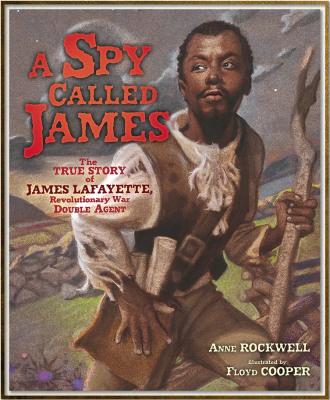
Grade Level: 3-5 Available from:
After his resounding defeat at the Battle of Yorktown, British general Charles Cornwallis made a point of touring the American camp, looking for the reason behind his loss. What he didn’t expect to see was James, an escaped enslaved person who had served as a guide to the British army. Or at least that’s what Cornwallis was led to believe. In fact, James wasn’t a freedom seeker—he was a spy for the American army.
But while America celebrated its newfound freedom, James returned to slavery in Virginia. His service as a spy hadn’t qualified him for the release he’d been hoping for. For James, the fight wasn’t over; his next adversary was the Virginia General Assembly. He’d already helped his country gain its freedom; now it was time to win his own.
Lexile Measure: 940
Historical Overview:
North Carolina was one of the original 13 colonies that were formed or became ruled by Great Britain in North America, hundreds of years ago. A colony is a land that is under the control or power of another country—often one that is far away. People from that faraway country (and other places) come to live in the controlled lands; they are settlers or colonists. Colonists started arriving in the land we call North Carolina more than 400 years ago; they displaced many of the people already living here—the American Indians. Some settlers to North Carolina did not come here willingly; enslaved people from other colonies and Africa were brought to live and work in this land too. Free people of color also lived in North Carolina.
Over time, many people living in 13 British colonies in North America—Connecticut, Delaware, Georgia, Maryland, Massachusetts, New Hampshire, New Jersey, New York, North Carolina, Pennsylvania, Rhode Island, South Carolina, and Virginia—wanted freedom from what they considered unfair laws from Great Britain. These people—Patriots—sought freedom to make their own rules and to not answer to a king and country so far away from them. Eventually, almost 250 years ago, the colonists—now calling themselves Americans—went to war with Great Britain to gain these freedoms.
Not everyone in the colonies wanted to separate from Great Britain—some remained loyal to the king; they were called Loyalists. American Indians had to decide how support for either the new United States of America or Great Britain would help them maintain their lands and ways of life. And enslaved people deeply understood the desire for freedom—but the political, economic, and social freedoms sought by those in power in America did not include extending freedom to people held in bondage.
North Carolina’s participation in the American Revolution—the war with Great Britain—began early.
- In October 1775, at a time when it was unusual for women to speak up publicly, a group of 51 women in Edenton wrote and signed a document saying they would not buy any British goods because Americans had no say in how the taxes on those items would be spent.
- One of the earliest battles of the war with Great Britain occurred in February 1776, near Wilmington, at Moores Creek , where Patriots defeated British and Loyalist forces.
- North Carolina was the first colony to officially say, “Let’s be independent!” with the Halifax Resolves in April 1776. The Patriots representing the 13 colonies, meeting in Philadelphia at the Second Continental Congress, voted for independence as stated in the Declaration of Independence. Americans celebrate this event each Fourth of July—the nation’s birthday. Some 6,000 to 7,000 North Carolina soldiers served in the Continental Line—the name of the army commanded by General George Washington—that fought for the United States against Great Britain during the seven years of war.
- A major battle of the war happened at Guilford Courthouse, near Greensboro, in March 1781. Although the British forces officially won this battle, they suffered many losses.
Like James, some enslaved people in North Carolina sought freedom during the Revolutionary War. The British offered freedom to enslaved people who joined their army, and some in the American forces—including General George Washington’s officers John Laurens, Alexander Hamilton, and the Marquis de Lafayette—encouraged allowing all men who wanted freedom to fight. Free men of color and enslaved men served in the American AND British forces from the beginning of the Revolution. However, the freedoms won during the American Revolution did not extend to enslaved people. They—along with women, free people of color, and American Indians—would continue fighting for freedom and equality.
Gilbert du Motier, the Marquis de Lafayette—James’s advocate for freedom—visited the United States decades after the Revolution in 1824–1825. He traveled to North Carolina, where he visited a famous statue of George Washington that was in the State Capitol in Raleigh. Lafayette also attended a ball—a party with dancing—before traveling to Fayetteville, which had been named in his honor. A few years later, the Capitol burned, and the statue was destroyed. A copy of it was made and sits in the rebuilt Capitol today.
Primary Sources:
Primary sources are created at the time of an event, or later by someone who witnessed or experienced something firsthand and shared about it later. We often think of primary sources as old letters, diaries, and documents—and that’s right! But other things are primary sources too! Buildings, shoes, portraits, objects, and more are also primary sources, and part of our job at the North Carolina Museum of History is to collect those objects and take care of them.
1948.65.1
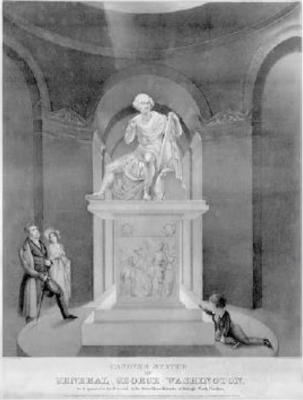
As part of the updates to the original capitol building in Raleigh, a statue honoring George Washington was included. Thomas Jefferson recommended well-known Italian sculptor Antonio Canova. The artist’s vision of the former general and president depicted Washington in Roman clothing, drafting his farewell address. Transporting the statue from Italy to North Carolina was its own adventure, but once installed, the statue became quite popular. In fact, Revolutionary War general Marquis de Lafayette visited the statue in 1825, as depicted in this lithograph.
19XX.213.12
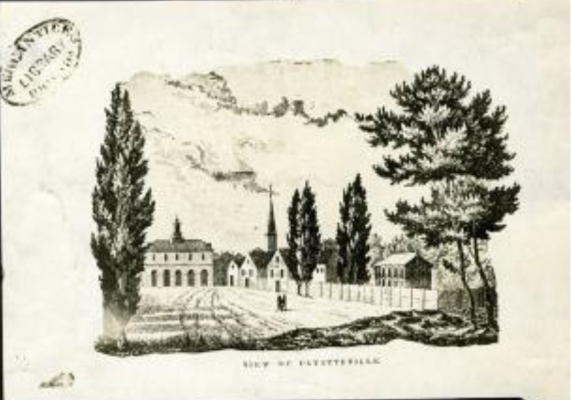
In May 1831, the city of Fayetteville—not Raleigh—was destroyed by fire; thankfully, no one died. A fire rushed through the town, burning more than 600 buildings.
19XX.75.1
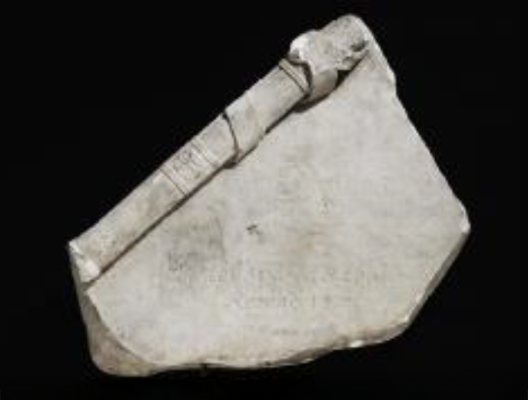
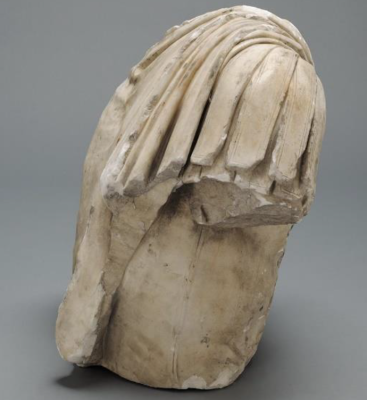
In Raleigh, government officials looked at the State Capitol building and seeing its wooden roof, recognized that it, too, could burn. To take every precaution, in
June 1831, they hired workers to put zinc plates on the roof of the capitol to make it fireproof. However, during this process, a smelting pot (where the workers used fire to melt zinc to affix the plates) tipped, starting a fire— while fireproofing—and the State House burned. The statue of George Washington was destroyed, as well. The General Assembly provided funds to rebuild the Capitol in Union Square. These marble fragments of the statue were saved following the fire.
1945.94.5
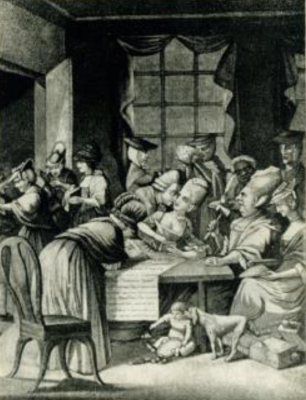
Penelope Barker led the effort to write resolves boycotting British goods in October 1774. The document was signed by 51 women in Edenton and sent to England. A newspaper in London, The Morning Chronicle and London Advertiser, published a cartoon portraying these women as undignified for making political statements. The cartoon appeared in the January 16, 1775, issue.
19XX.10.1

This is the key to the building in Halifax, where the Fourth Provincial Congress met in April 1776, and on April 12, passed resolves instructing the North Carolina delegation at the Second Continental Congress meeting in Philadelphia to declare “independency.” North Carolina was the first to make such a declaration.
Vocabulary:
- Essential—necessary or very important
- Famous—known by many people
- Impressive—grand, awesome, creating admiration through size or quality
- Infamous—well known for a bad quality or deed
- Misleading—intentionally giving the wrong idea
- Outraged—angered or shocked by someone or something
- Poised—having a composed and self-assured manner
- Redcoats—British soldiers
Discussion Questions:
- Why do you think James wanted to serve in the Continental army?
- For what reasons do you think James’s enslaver allowed him to join the Continental army?
- Did anything about the story surprise you?
- How do the illustrations help you understand what the characters are doing or feeling?
- Why do you think it took James so many years to gain his freedom?
- What questions do you have about the people or events in the story?
Activity: Colonial Coloring Pages
Supplies:
- Copies of Colonial Coloring Pages (available in English and Spanish)
- Crayons, colored pencils, markers
Instructions:
- Distribute copies of Colonial Coloring Pages and supplies to students.
- Have students complete the coloring pages.
- Ask:
• How are these clothes the same as what you wear? How do they differ?
• How long do you think it took to dress in 1760?
• What do you think these clothes were made from?
• Where did people get clothes?
Watch: Artifact Chitchat
This short seven-minute film brings some of the museum’s American Revolution–related “stuff” to life!



